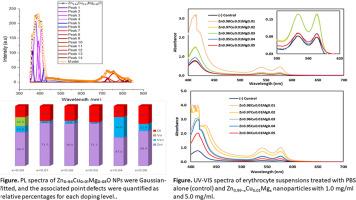Structural, mechanical and biomedical impacts of defects in Cu/Mg Co-doped ZnO nanoparticles
IF 3
Q2 PHYSICS, CONDENSED MATTER
引用次数: 0
Abstract
Zn0.99-xCu0.01MgxO (x = 0–0.05) nanoparticles were synthesized by a sol–gel route and examined to relate doping-induced lattice defects to biocompatibility for prospective biomedical use. X-ray diffraction confirmed single-phase wurtzite with no secondary phases, while Williamson–Hall models provided crystallite size and lattice microstrain/stress, separating strain from size effects. Photoluminescence (UV–visible) showed an Mg-dependent defect redistribution suppression of the green band (VO) with concomitant changes in Zni, VZn, and Oi centers. SEM/EDS verified the expected composition and quasi-spherical agglomerated morphology. Hemolysis assays on human erythrocytes revealed a monotonic decrease in lysis with increasing Mg; samples with x ≥ 0.04 were non-hemolytic at 1.0 mg/mL (ISO <5 %). Overall, Mg-enabled defect passivation particularly VO suppression correlates with improved blood compatibility, indicating that Cu/Mg co-doping is a practical lever to tailor ZnO nanoparticles for blood-contacting coatings, sensors, and implant interfaces.

Cu/Mg共掺杂ZnO纳米粒子缺陷的结构、力学和生物医学影响
采用溶胶-凝胶法合成了Zn0.99-xCu0.01MgxO (x = 0-0.05)纳米粒子,并研究了掺杂诱导的晶格缺陷与生物相容性之间的关系。x射线衍射证实了单相纤锌矿没有二次相,而Williamson-Hall模型提供了晶体尺寸和晶格微应变/应力,将应变与尺寸效应分离开来。光致发光(紫外可见)显示出镁依赖的绿带(VO)缺陷再分布抑制,并伴随Zni, VZn和Oi中心的变化。SEM/EDS验证了预期的成分和准球形团聚形貌。人红细胞溶血实验显示,随着Mg的增加,溶血量单调下降;x≥0.04的样品在1.0 mg/mL (ISO < 5%)时无溶血作用。总的来说,Mg使缺陷钝化,特别是VO抑制与血液相容性的改善相关,表明Cu/Mg共掺杂是定制ZnO纳米颗粒用于血液接触涂层,传感器和植入物界面的实用手段。
本文章由计算机程序翻译,如有差异,请以英文原文为准。
求助全文
约1分钟内获得全文
求助全文

 求助内容:
求助内容: 应助结果提醒方式:
应助结果提醒方式:


